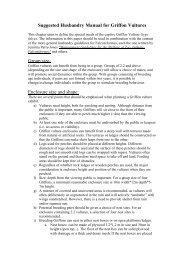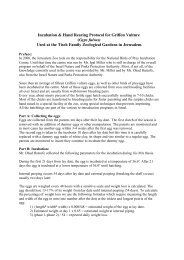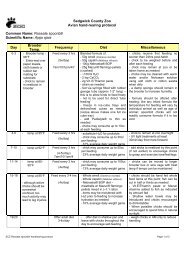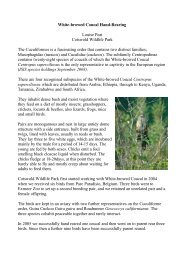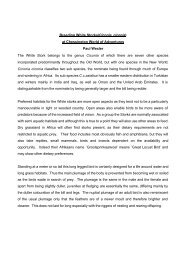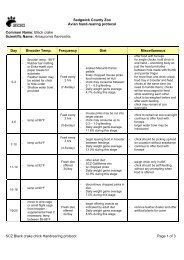Hand-rearing Pigeons and Doves At Bristol Zoo - Avian Rearing ...
Hand-rearing Pigeons and Doves At Bristol Zoo - Avian Rearing ...
Hand-rearing Pigeons and Doves At Bristol Zoo - Avian Rearing ...
Create successful ePaper yourself
Turn your PDF publications into a flip-book with our unique Google optimized e-Paper software.
HAND-REARING PIGEONS AND DOVES<br />
AT BRISTOL ZOO GARDENS<br />
by Nigel Simpson<br />
121<br />
Introduction<br />
<strong>Pigeons</strong> <strong>and</strong> doves have been successfully h<strong>and</strong>-reared in several<br />
institutions, but often with subsequent attempts these successes were not able<br />
to be repeated. <strong>Bristol</strong> <strong>Zoo</strong> has an extensive collection of pigeons <strong>and</strong> doves<br />
<strong>and</strong> has for many years successfully reared the young of several species,<br />
both by parent-<strong>rearing</strong> <strong>and</strong> the use of foster parents. On many occasions<br />
in the past h<strong>and</strong>-<strong>rearing</strong> was attempted but there were high rates of failure.<br />
Several diets <strong>and</strong> methods of <strong>rearing</strong> have been reported as having been<br />
successfully used to h<strong>and</strong>-rear Columbidae (Blanchard, 1992; Bell, 1981;<br />
Harrington et al. 1999). In 2004 a new diet <strong>and</strong> method used successfully<br />
by Chelle Plasse at Disney’s Animal Kingdom¹, Florida, USA, which came<br />
with the suggestion that the method of feeding is more important than the<br />
actual content of the diet, were trial led at <strong>Bristol</strong> <strong>Zoo</strong>.<br />
By following the Plasse diet <strong>and</strong> method of <strong>rearing</strong>, we succeeded in<br />
successfully <strong>rearing</strong> Victoria Crowned <strong>Pigeons</strong> Goura victoria <strong>and</strong> Whitenaped<br />
Pheasant <strong>Pigeons</strong> Otidiphaps nobilis aruensis at <strong>Bristol</strong> <strong>Zoo</strong>.<br />
Method<br />
The diet consists of Avi-Plus parrot breeder pellets (20% protein, 8% fat)<br />
that were soaked in water overnight until all of the water had been absorbed.<br />
They were then cooked in a microwave for approximately two minutes until<br />
the mixture has homogenised <strong>and</strong> become runny. An alternative method is<br />
to heat the mixture in a saucepan on a conventional hob until the mixture<br />
is of the required consistency. We have also used the formula uncooked,<br />
by liquidising the soaked pellets until they have reached the required<br />
consistency. In the latter stages of <strong>rearing</strong>, fruit can easily be added to the<br />
formula. The prepared formula can be stored in a sealable food container<br />
<strong>and</strong> kept in a fridge for up to 24 hours, after which any unused food should<br />
be discarded.<br />
Newly-hatched squabs can be fed from day zero. If they hatch early<br />
in the day they can be given an initial drink of water <strong>and</strong> feeding with the<br />
formula can commence in the afternoon. Squabs that hatch late in the day<br />
¹ This refers to a DVD produced by Chelle Plasse <strong>and</strong> Disney’s Animal<br />
Kingdom. The author has also produced a DVD on the subject. Details<br />
on how to obtain copies of these DVDs are available from: Chelle.Plasse@<br />
disney.com <strong>and</strong> nsimpson@bristolzoo.org.uk
122<br />
SImPSON - HAND-reArING PIGeONS AND DOVeS<br />
Fig. 1. Growth rate of Victoria Crowned Pigeon squabs. .........................<br />
should receive only a drink of water on day zero <strong>and</strong> feeding with the formula<br />
should commence the following day (day one).<br />
Squabs are fed using a 2.5ml pipette with the tip cut at an angle of fortyfive<br />
degrees. Having it cut at an angle makes feeding easier <strong>and</strong> in the case<br />
of difficult squabs, means that it can also be used to gently prise open the<br />
upper <strong>and</strong> lower m<strong>and</strong>ibles. The formula should be heated by st<strong>and</strong>ing it<br />
in a bowl in boiling water. It is important to test the temperature of the<br />
formula on the back of the h<strong>and</strong> before attempting to feed it to the squab. If<br />
it is too hot it will, of course, burn the squab <strong>and</strong>, if it is too cold, the squab<br />
may refuse to eat it.<br />
Squabs are fed initially by slightly prising open the m<strong>and</strong>ible <strong>and</strong><br />
dribbling the formula into the lower m<strong>and</strong>ible <strong>and</strong> allowing the squab to<br />
voluntarily swallow it. The formula needs to be fairly runny at this stage<br />
to enable it to flow into the squab’s lower m<strong>and</strong>ible. It is important to fill<br />
the crop to its maximum capacity in order to stretch the walls of the crop in<br />
preparation for the large volumes of food which will be eaten later. As the<br />
squabs grow larger <strong>and</strong> become accustomed to being fed by h<strong>and</strong> they begin<br />
to solicit food <strong>and</strong> open their beaks more easily. Also, as they continue to<br />
grow larger the thickness of the formula can be increased <strong>and</strong> the delivery<br />
method will need to be changed <strong>and</strong> the squabs fed from a syringe. Large<br />
syringes can have the end cut off <strong>and</strong> the squab will insert its entire beak<br />
into the end <strong>and</strong> take the formula from it. There will be little need to use the<br />
plunger at this stage, as the squab will suck out the formula for itself.
SImPSON - HAND-reArING PIGeONS AND DOVeS<br />
Fig. 2. Growth rate of Pied Imperial Pigeon squab.<br />
123<br />
With most birds a good indicator that the <strong>rearing</strong> process is going well is<br />
that the chick’s crop is emptying between feeds. With this method, however,<br />
the crop should be filled at each feed <strong>and</strong> should remain full throughout<br />
the day <strong>and</strong> be allowed to empty only overnight. When you go to feed the<br />
squab, it may seem unusual to discover that it still has some food in its crop,<br />
but it nonetheless needs to be filled again. It is felt that maintaining a full<br />
crop has the effect of getting sufficient food into the squab <strong>and</strong> helps the<br />
formula move through its system. most squabs pass faeces after each feed<br />
<strong>and</strong> this is generally a good indicator that all is going well. If it appears<br />
that the squab is not digesting the formula <strong>and</strong> has stopped passing faeces,<br />
increasing the humidity in the brooder may help. The humidity level should<br />
be maintained at about 60% (rh).<br />
The squabs are weighed each morning <strong>and</strong> their weights are plotted on<br />
excel spreadsheets. Growth rates for parent-reared pigeons <strong>and</strong> doves are<br />
known to be over 20% per day. However, for h<strong>and</strong>-reared Victoria Crowned<br />
<strong>Pigeons</strong> it can be 10% per day (see Fig.1), but other taxa have been reared at<br />
higher levels, more like those of parent-reared squabs (Fig.2). The volume<br />
of food taken by squabs varies depending on the species <strong>and</strong> its age. Fig.3<br />
shows the total volume of food consumed by a pheasant pigeon during the<br />
first 10 days of <strong>rearing</strong>.
124<br />
SImPSON - HAND-reArING PIGeONS AND DOVeS<br />
<strong>Rearing</strong> schedule for Victoria Crowned Pigeon.<br />
Age Feeds Average Average Comments<br />
(days) per day temperature humidity<br />
0-11 8 36°C 65% Fed using 2.5ml pipette with end cut at an<br />
(96.8°F) angle.<br />
12-19 6 32°C 65% Fed using 5ml syringe with end cut at an<br />
(89.6°F) angle <strong>and</strong> allowing squab to fully insert<br />
beak <strong>and</strong> suck out food.<br />
<strong>At</strong> 17 days heat turned off during daytime.<br />
20-30 4 24°C 65% Fed using 10ml syringe with end cut off.<br />
(75.2°F) From 25 days onwards a 20ml syringe<br />
was used.<br />
31-33 3 Ambient Ambient Fed using 20ml syringe. Formula changed<br />
to Avi-Plus pellets <strong>and</strong> liquidised fruit.<br />
33-weaning Ambient Ambient Squab begs for food <strong>and</strong> is fed small pieces<br />
of fruit <strong>and</strong> (Kaytee exact) low iron pellets.<br />
These are placed in the beak <strong>and</strong> are<br />
swallowed by the bird it was later moved<br />
into an enclosure with bleeding heart doves<br />
to encourage it to learn to feed itself.<br />
Weaning<br />
As the squab grows, depending on the species, either fruit or grain can<br />
be added to the formula. Fruit should at first be puréed <strong>and</strong> then later cut<br />
into pieces <strong>and</strong> mixed in with the formula. As the squab continues to grow<br />
larger, small pieces of fruit can be placed in its open beak <strong>and</strong> a small bowl<br />
of food can be left with the bird to encourage it to feed itself. It is crucial to<br />
monitor its weight at this time to ensure that it is eating sufficient food, <strong>and</strong><br />
is not losing too much weight. If at any point it is felt that the squab is not<br />
eating enough, a single feed of the formula can be given in the morning, to<br />
ensure the bird is receiving sufficient nutrition.<br />
Summary<br />
<strong>H<strong>and</strong></strong>-<strong>rearing</strong> formula<br />
Avi-Plus parrot breeder pellets (protein 20%, fat 8%)<br />
Preparation<br />
Quantity of pellets soaked in water overnight until the pellets have absorbed<br />
the water <strong>and</strong> swollen.<br />
Soaked pellets micro-waved on high setting for approximately two minutes<br />
until they have homogenised into a runny consistency.<br />
Formula stored in fridge <strong>and</strong> used as required. Any unused food is discarded<br />
after 24 hours.<br />
The consistency of the formula can be varied by adding more or less<br />
water.
SImPSON - HAND-reArING PIGeONS AND DOVeS<br />
Fig. 3. Daily food intake of White-naped Pheasant Pigeon<br />
125<br />
Feeding method<br />
Hold the head between the thumb <strong>and</strong> forefinger <strong>and</strong> offer the tip of the<br />
pipette to the squab.<br />
To encourage the squab to voluntarily swallow the formula, run it down the<br />
inside of the lower m<strong>and</strong>ible.<br />
Fill crop at each feed <strong>and</strong> do not allow it to empty during the day, but leave<br />
it to empty overnight. This is the most important part of the method <strong>and</strong> is<br />
crucial for successful h<strong>and</strong>-<strong>rearing</strong>. Do not overfill the crop as regurgitation<br />
may lead to aspiration <strong>and</strong> death.<br />
Feed every two hours from 6.00am-10.00pm, i.e. eight times a day.<br />
monitor defecation <strong>and</strong> if problems arise increase the humidity <strong>and</strong> dilute<br />
formula by adding more water.<br />
References<br />
Bell, K. J. 1981. Breeding <strong>and</strong> h<strong>and</strong>-<strong>rearing</strong> the Nicobar Pigeon Caloenas nicobarica.<br />
International <strong>Zoo</strong> Yearbook Vol. 21.<br />
Blachard, B. 1992. <strong>H<strong>and</strong></strong>-<strong>rearing</strong> a New Zeal<strong>and</strong> Pigeon Hemipha n. novaeseel<strong>and</strong>iae.<br />
International <strong>Zoo</strong> Yearbook Vol. 31.<br />
Harrington, P., Ferguson, A. <strong>and</strong> Joseph, P. 1999. <strong>H<strong>and</strong></strong>-<strong>rearing</strong> a Superb Fruit Dove Ptilinopus<br />
superbus at London <strong>Zoo</strong>. Avicultural Magazine 105,2:57-64.<br />
Nigel Simpson is Curator of Birds at <strong>Bristol</strong> <strong>Zoo</strong> Gardens, Clifton, <strong>Bristol</strong><br />
BS8 3HA, UK. Website:www.bristolzoo.org.uk



